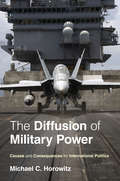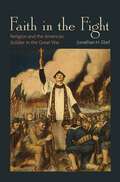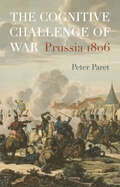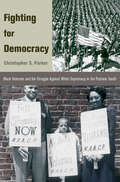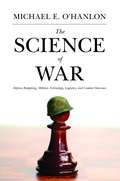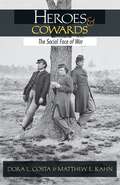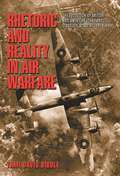- Table View
- List View
The Diffusion of Military Power: Causes and Consequences for International Politics
by Michael C. HorowitzThe Diffusion of Military Power examines how the financial and organizational challenges of adopting new methods of fighting wars can influence the international balance of power. Michael Horowitz argues that a state or actor wishing to adopt a military innovation must possess both the financial resources to buy or build the technology and the internal organizational capacity to accommodate any necessary changes in recruiting, training, or operations. How countries react to new innovations--and to other actors that do or don't adopt them--has profound implications for the global order and the likelihood of war. Horowitz looks at some of the most important military innovations throughout history, including the advent of the all-big-gun steel battleship, the development of aircraft carriers and nuclear weapons, and the use of suicide terror by nonstate actors. He shows how expensive innovations can favor wealthier, more powerful countries, but also how those same states often stumble when facing organizationally complicated innovations. Innovations requiring major upheavals in doctrine and organization can disadvantage the wealthiest states due to their bureaucratic inflexibility and weight the balance of power toward smaller and more nimble actors, making conflict more likely. This book provides vital insights into military innovations and their impact on U.S. foreign policy, warfare, and the distribution of power in the international system.
The Diffusion of Military Power: Causes and Consequences for International Politics
by Michael C. HorowitzThe Diffusion of Military Power examines how the financial and organizational challenges of adopting new methods of fighting wars can influence the international balance of power. Michael Horowitz argues that a state or actor wishing to adopt a military innovation must possess both the financial resources to buy or build the technology and the internal organizational capacity to accommodate any necessary changes in recruiting, training, or operations. How countries react to new innovations--and to other actors that do or don't adopt them--has profound implications for the global order and the likelihood of war. Horowitz looks at some of the most important military innovations throughout history, including the advent of the all-big-gun steel battleship, the development of aircraft carriers and nuclear weapons, and the use of suicide terror by nonstate actors. He shows how expensive innovations can favor wealthier, more powerful countries, but also how those same states often stumble when facing organizationally complicated innovations. Innovations requiring major upheavals in doctrine and organization can disadvantage the wealthiest states due to their bureaucratic inflexibility and weight the balance of power toward smaller and more nimble actors, making conflict more likely. This book provides vital insights into military innovations and their impact on U.S. foreign policy, warfare, and the distribution of power in the international system.
Faith in the Fight: Religion and the American Soldier in the Great War
by Jonathan H. EbelFaith in the Fight tells a story of religion, soldiering, suffering, and death in the Great War. Recovering the thoughts and experiences of American troops, nurses, and aid workers through their letters, diaries, and memoirs, Jonathan Ebel describes how religion--primarily Christianity--encouraged these young men and women to fight and die, sustained them through war's chaos, and shaped their responses to the war's aftermath. The book reveals the surprising frequency with which Americans who fought viewed the war as a religious challenge that could lead to individual and national redemption. Believing in a "Christianity of the sword," these Americans responded to the war by reasserting their religious faith and proclaiming America God-chosen and righteous in its mission. And while the war sometimes challenged these beliefs, it did not fundamentally alter them. Revising the conventional view that the war was universally disillusioning, Faith in the Fight argues that the war in fact strengthened the religious beliefs of the Americans who fought, and that it helped spark a religiously charged revival of many prewar orthodoxies during a postwar period marked by race riots, labor wars, communist witch hunts, and gender struggles. For many Americans, Ebel argues, the postwar period was actually one of "reillusionment." Demonstrating the deep connections between Christianity and Americans' experience of the First World War, Faith in the Fight encourages us to examine the religious dimensions of America's wars, past and present, and to work toward a deeper understanding of religion and violence in American history.
Nothing Less than Victory: Decisive Wars and the Lessons of History
by John David LewisThe goal of war is to defeat the enemy's will to fight. But how this can be accomplished is a thorny issue. Nothing Less than Victory provocatively shows that aggressive, strategic military offenses can win wars and establish lasting peace, while defensive maneuvers have often led to prolonged carnage, indecision, and stalemate. Taking an ambitious and sweeping look at six major wars, from antiquity to World War II, John David Lewis shows how victorious military commanders have achieved long-term peace by identifying the core of the enemy's ideological, political, and social support for a war, fiercely striking at this objective, and demanding that the enemy acknowledges its defeat. Lewis examines the Greco-Persian and Theban wars, the Second Punic War, Aurelian's wars to reunify Rome, the American Civil War, and the Second World War. He considers successful examples of overwhelming force, such as the Greek mutilation of Xerxes' army and navy, the Theban-led invasion of the Spartan homeland, and Hannibal's attack against Italy--as well as failed tactics of defense, including Fabius's policy of delay, McClellan's retreat from Richmond, and Chamberlain's appeasement of Hitler. Lewis shows that a war's endurance rests in each side's reasoning, moral purpose, and commitment to fight, and why an effectively aimed, well-planned, and quickly executed offense can end a conflict and create the conditions needed for long-term peace. Recognizing the human motivations behind military conflicts, Nothing Less than Victory makes a powerful case for offensive actions in pursuit of peace.
Makers of Ancient Strategy: From the Persian Wars to the Fall of Rome
by Victor Davis HansonIn this prequel to the now-classic Makers of Modern Strategy, Victor Davis Hanson, a leading scholar of ancient military history, gathers prominent thinkers to explore key facets of warfare, strategy, and foreign policy in the Greco-Roman world. From the Persian Wars to the final defense of the Roman Empire, Makers of Ancient Strategy demonstrates that the military thinking and policies of the ancient Greeks and Romans remain surprisingly relevant for understanding conflict in the modern world. The book reveals that much of the organized violence witnessed today--such as counterterrorism, urban fighting, insurgencies, preemptive war, and ethnic cleansing--has ample precedent in the classical era. The book examines the preemption and unilateralism used to instill democracy during Epaminondas's great invasion of the Peloponnesus in 369 BC, as well as the counterinsurgency and terrorism that characterized Rome's battles with insurgents such as Spartacus, Mithridates, and the Cilician pirates. The collection looks at the urban warfare that became increasingly common as more battles were fought within city walls, and follows the careful tactical strategies of statesmen as diverse as Pericles, Demosthenes, Alexander, Pyrrhus, Caesar, and Augustus. Makers of Ancient Strategy shows how Greco-Roman history sheds light on wars of every age. In addition to the editor, the contributors are David L. Berkey, Adrian Goldsworthy, Peter J. Heather, Tom Holland, Donald Kagan, John W. I. Lee, Susan Mattern, Barry Strauss, and Ian Worthington.
Makers of Ancient Strategy: From the Persian Wars to the Fall of Rome
by Victor Davis HansonIn this prequel to the now-classic Makers of Modern Strategy, Victor Davis Hanson, a leading scholar of ancient military history, gathers prominent thinkers to explore key facets of warfare, strategy, and foreign policy in the Greco-Roman world. From the Persian Wars to the final defense of the Roman Empire, Makers of Ancient Strategy demonstrates that the military thinking and policies of the ancient Greeks and Romans remain surprisingly relevant for understanding conflict in the modern world. The book reveals that much of the organized violence witnessed today--such as counterterrorism, urban fighting, insurgencies, preemptive war, and ethnic cleansing--has ample precedent in the classical era. The book examines the preemption and unilateralism used to instill democracy during Epaminondas's great invasion of the Peloponnesus in 369 BC, as well as the counterinsurgency and terrorism that characterized Rome's battles with insurgents such as Spartacus, Mithridates, and the Cilician pirates. The collection looks at the urban warfare that became increasingly common as more battles were fought within city walls, and follows the careful tactical strategies of statesmen as diverse as Pericles, Demosthenes, Alexander, Pyrrhus, Caesar, and Augustus. Makers of Ancient Strategy shows how Greco-Roman history sheds light on wars of every age. In addition to the editor, the contributors are David L. Berkey, Adrian Goldsworthy, Peter J. Heather, Tom Holland, Donald Kagan, John W. I. Lee, Susan Mattern, Barry Strauss, and Ian Worthington.
The Cognitive Challenge of War: Prussia 1806
by Peter ParetResponding to the enemy's innovation in war presents problems to soldiers and societies of all times. This book traces Napoleon's victory over Prussia in 1806 and Prussia's effort to recover from defeat to show how in one particular historical episode operational analyses together with institutional and political decisions eventually turned defeat to victory. The author moves from a comparative study of French and Prussian forces to campaign narrative and strategic analysis. He examines processes of change in institutions and doctrine, as well as their dependence on social and political developments, and interprets works of art and literature as indicators of popular and elite attitudes toward war, which influence the conduct of war and the kind and extent of military innovation. In the concluding chapter he addresses the impact of 1806 on two men who fought on opposing sides in the campaign and sought a new theoretical understanding of war--Henri Jomini and Carl von Clausewitz. Fields of history that are often kept separate are brought together in this book, which seeks to replicate the links between different areas of thought and action as they exist in reality and shape events.
How Wars End
by Dan ReiterWhy do some countries choose to end wars short of total victory while others fight on, sometimes in the face of appalling odds? How Wars End argues that two central factors shape war-termination decision making: information about the balance of power and the resolve of one's enemy, and fears that the other side's commitment to abide by a war-ending peace settlement may not be credible. Dan Reiter explains how information about combat outcomes and other factors may persuade a warring nation to demand more or less in peace negotiations, and why a country might refuse to negotiate limited terms and instead tenaciously pursue absolute victory if it fears that its enemy might renege on a peace deal. He fully lays out the theory and then tests it on more than twenty cases of war-termination behavior, including decisions during the American Civil War, the two world wars, and the Korean War. Reiter helps solve some of the most enduring puzzles in military history, such as why Abraham Lincoln issued the Emancipation Proclamation, why Germany in 1918 renewed its attack in the West after securing peace with Russia in the East, and why Britain refused to seek peace terms with Germany after France fell in 1940. How Wars End concludes with a timely discussion of twentieth-century American foreign policy, framing the Bush Doctrine's emphasis on preventive war in the context of the theory.
Fighting for Democracy: Black Veterans and the Struggle Against White Supremacy in the Postwar South
by Christopher S. ParkerFighting for Democracy shows how the experiences of African American soldiers during World War II and the Korean War influenced many of them to challenge white supremacy in the South when they returned home. Focusing on the motivations of individual black veterans, this groundbreaking book explores the relationship between military service and political activism. Christopher Parker draws on unique sources of evidence, including interviews and survey data, to illustrate how and why black servicemen who fought for their country in wartime returned to America prepared to fight for their own equality. Parker discusses the history of African American military service and how the wartime experiences of black veterans inspired them to contest Jim Crow. Black veterans gained courage and confidence by fighting their nation's enemies on the battlefield and racism in the ranks. Viewing their military service as patriotic sacrifice in the defense of democracy, these veterans returned home with the determination and commitment to pursue equality and social reform in the South. Just as they had risked their lives to protect democratic rights while abroad, they risked their lives to demand those same rights on the domestic front. Providing a sophisticated understanding of how war abroad impacts efforts for social change at home, Fighting for Democracy recovers a vital story about black veterans and demonstrates their distinct contributions to the American political landscape.
The Science of War: Defense Budgeting, Military Technology, Logistics, and Combat Outcomes
by Michael E. O'HanlonThe U.S. military is one of the largest and most complex organizations in the world. How it spends its money, chooses tactics, and allocates its resources have enormous implications for national defense and the economy. The Science of War is the only comprehensive textbook on how to analyze and understand these and other essential problems in modern defense policy. Michael O'Hanlon provides undergraduate and graduate students with an accessible yet rigorous introduction to the subject. Drawing on a broad range of sources and his own considerable expertise as a defense analyst and teacher, he describes the analytic techniques the military uses in every crucial area of military science. O'Hanlon explains how the military budget works, how the military assesses and deploys new technology, develops strategy and fights wars, handles the logistics of stationing and moving troops and equipment around the world, and models and evaluates battlefield outcomes. His modeling techniques have been tested in Iraq and Afghanistan, including the methods he used to predict higher-than-anticipated troop fatalities in Iraq--controversial predictions that have since been vindicated. The Science of War is the definitive resource on warfare in the twenty-first century. Gives the best introduction to defense analysis available Covers defense budgeting Shows how to model and predict outcomes in war Explains military logistics, including overseas basing Examines key issues in military technology, including missile defense, space warfare, and nuclear-weapons testing Based on the author's graduate-level courses at Princeton, Columbia, and Georgetown universities
The Science of War: Defense Budgeting, Military Technology, Logistics, and Combat Outcomes
by Michael E. O'HanlonThe U.S. military is one of the largest and most complex organizations in the world. How it spends its money, chooses tactics, and allocates its resources have enormous implications for national defense and the economy. The Science of War is the only comprehensive textbook on how to analyze and understand these and other essential problems in modern defense policy. Michael O'Hanlon provides undergraduate and graduate students with an accessible yet rigorous introduction to the subject. Drawing on a broad range of sources and his own considerable expertise as a defense analyst and teacher, he describes the analytic techniques the military uses in every crucial area of military science. O'Hanlon explains how the military budget works, how the military assesses and deploys new technology, develops strategy and fights wars, handles the logistics of stationing and moving troops and equipment around the world, and models and evaluates battlefield outcomes. His modeling techniques have been tested in Iraq and Afghanistan, including the methods he used to predict higher-than-anticipated troop fatalities in Iraq--controversial predictions that have since been vindicated. The Science of War is the definitive resource on warfare in the twenty-first century. Gives the best introduction to defense analysis available Covers defense budgeting Shows how to model and predict outcomes in war Explains military logistics, including overseas basing Examines key issues in military technology, including missile defense, space warfare, and nuclear-weapons testing Based on the author's graduate-level courses at Princeton, Columbia, and Georgetown universities
Torture and Democracy
by Darius RejaliThis is the most comprehensive, and most comprehensively chilling, study of modern torture yet written. Darius Rejali, one of the world's leading experts on torture, takes the reader from the late nineteenth century to the aftermath of Abu Ghraib, from slavery and the electric chair to electrotorture in American inner cities, and from French and British colonial prison cells and the Spanish-American War to the fields of Vietnam, the wars of the Middle East, and the new democracies of Latin America and Europe. As Rejali traces the development and application of one torture technique after another in these settings, he reaches startling conclusions. As the twentieth century progressed, he argues, democracies not only tortured, but set the international pace for torture. Dictatorships may have tortured more, and more indiscriminately, but the United States, Britain, and France pioneered and exported techniques that have become the lingua franca of modern torture: methods that leave no marks. Under the watchful eyes of reporters and human rights activists, low-level authorities in the world's oldest democracies were the first to learn that to scar a victim was to advertise iniquity and invite scandal. Long before the CIA even existed, police and soldiers turned instead to "clean" techniques, such as torture by electricity, ice, water, noise, drugs, and stress positions. As democracy and human rights spread after World War II, so too did these methods. Rejali makes this troubling case in fluid, arresting prose and on the basis of unprecedented research--conducted in multiple languages and on several continents--begun years before most of us had ever heard of Osama bin Laden or Abu Ghraib. The author of a major study of Iranian torture, Rejali also tackles the controversial question of whether torture really works, answering the new apologists for torture point by point. A brave and disturbing book, this is the benchmark against which all future studies of modern torture will be measured.
Torture and Democracy
by Darius RejaliThis is the most comprehensive, and most comprehensively chilling, study of modern torture yet written. Darius Rejali, one of the world's leading experts on torture, takes the reader from the late nineteenth century to the aftermath of Abu Ghraib, from slavery and the electric chair to electrotorture in American inner cities, and from French and British colonial prison cells and the Spanish-American War to the fields of Vietnam, the wars of the Middle East, and the new democracies of Latin America and Europe. As Rejali traces the development and application of one torture technique after another in these settings, he reaches startling conclusions. As the twentieth century progressed, he argues, democracies not only tortured, but set the international pace for torture. Dictatorships may have tortured more, and more indiscriminately, but the United States, Britain, and France pioneered and exported techniques that have become the lingua franca of modern torture: methods that leave no marks. Under the watchful eyes of reporters and human rights activists, low-level authorities in the world's oldest democracies were the first to learn that to scar a victim was to advertise iniquity and invite scandal. Long before the CIA even existed, police and soldiers turned instead to "clean" techniques, such as torture by electricity, ice, water, noise, drugs, and stress positions. As democracy and human rights spread after World War II, so too did these methods. Rejali makes this troubling case in fluid, arresting prose and on the basis of unprecedented research--conducted in multiple languages and on several continents--begun years before most of us had ever heard of Osama bin Laden or Abu Ghraib. The author of a major study of Iranian torture, Rejali also tackles the controversial question of whether torture really works, answering the new apologists for torture point by point. A brave and disturbing book, this is the benchmark against which all future studies of modern torture will be measured.
Paying the Human Costs of War: American Public Opinion and Casualties in Military Conflicts
by Christopher Gelpi Peter D. Feaver Jason ReiflerFrom the Korean War to the current conflict in Iraq, Paying the Human Costs of War examines the ways in which the American public decides whether to support the use of military force. Contrary to the conventional view, the authors demonstrate that the public does not respond reflexively and solely to the number of casualties in a conflict. Instead, the book argues that the public makes reasoned and reasonable cost-benefit calculations for their continued support of a war based on the justifications for it and the likelihood it will succeed, along with the costs that have been suffered in casualties. Of these factors, the book finds that the most important consideration for the public is the expectation of success. If the public believes that a mission will succeed, the public will support it even if the costs are high. When the public does not expect the mission to succeed, even small costs will cause the withdrawal of support. Providing a wealth of new evidence about American attitudes toward military conflict, Paying the Human Costs of War offers insights into a controversial, timely, and ongoing national discussion.
Heroes and Cowards: The Social Face of War
by Dora L. Costa Matthew E. KahnWhen are people willing to sacrifice for the common good? What are the benefits of friendship? How do communities deal with betrayal? And what are the costs and benefits of being in a diverse community? Using the life histories of more than forty thousand Civil War soldiers, Dora Costa and Matthew Kahn answer these questions and uncover the vivid stories, social influences, and crucial networks that influenced soldiers' lives both during and after the war. Drawing information from government documents, soldiers' journals, and one of the most extensive research projects about Union Army soldiers ever undertaken, Heroes and Cowards demonstrates the role that social capital plays in people's decisions. The makeup of various companies--whether soldiers were of the same ethnicity, age, and occupation--influenced whether soldiers remained loyal or whether they deserted. Costa and Kahn discuss how the soldiers benefited from friendships, what social factors allowed some to survive the POW camps while others died, and how punishments meted out for breaking codes of conduct affected men after the war. The book also examines the experience of African-American soldiers and makes important observations about how their comrades shaped their lives. Heroes and Cowards highlights the inherent tensions between the costs and benefits of community diversity, shedding light on how groups and societies behave and providing valuable lessons for the present day.
Nuclear Logics: Contrasting Paths in East Asia and the Middle East
by Etel SolingenNuclear Logics examines why some states seek nuclear weapons while others renounce them. Looking closely at nine cases in East Asia and the Middle East, Etel Solingen finds two distinct regional patterns. In East Asia, the norm since the late 1960s has been to forswear nuclear weapons, and North Korea, which makes no secret of its nuclear ambitions, is the anomaly. In the Middle East the opposite is the case, with Iran, Iraq, Israel, and Libya suspected of pursuing nuclear-weapons capabilities, with Egypt as the anomaly in recent decades. Identifying the domestic conditions underlying these divergent paths, Solingen argues that there are clear differences between states whose leaders advocate integration in the global economy and those that reject it. Among the former are countries like South Korea, Taiwan, and Japan, whose leaders have had stronger incentives to avoid the political, economic, and other costs of acquiring nuclear weapons. The latter, as in most cases in the Middle East, have had stronger incentives to exploit nuclear weapons as tools in nationalist platforms geared to helping their leaders survive in power. Solingen complements her bold argument with other logics explaining nuclear behavior, including security dilemmas, international norms and institutions, and the role of democracy and authoritarianism. Her account charts the most important frontier in understanding nuclear proliferation: grasping the relationship between internal and external political survival. Nuclear Logics is a pioneering book that is certain to provide an invaluable resource for researchers, teachers, and practitioners while reframing the policy debate surrounding nonproliferation.
Nuclear Logics: Contrasting Paths in East Asia and the Middle East
by Etel SolingenNuclear Logics examines why some states seek nuclear weapons while others renounce them. Looking closely at nine cases in East Asia and the Middle East, Etel Solingen finds two distinct regional patterns. In East Asia, the norm since the late 1960s has been to forswear nuclear weapons, and North Korea, which makes no secret of its nuclear ambitions, is the anomaly. In the Middle East the opposite is the case, with Iran, Iraq, Israel, and Libya suspected of pursuing nuclear-weapons capabilities, with Egypt as the anomaly in recent decades. Identifying the domestic conditions underlying these divergent paths, Solingen argues that there are clear differences between states whose leaders advocate integration in the global economy and those that reject it. Among the former are countries like South Korea, Taiwan, and Japan, whose leaders have had stronger incentives to avoid the political, economic, and other costs of acquiring nuclear weapons. The latter, as in most cases in the Middle East, have had stronger incentives to exploit nuclear weapons as tools in nationalist platforms geared to helping their leaders survive in power. Solingen complements her bold argument with other logics explaining nuclear behavior, including security dilemmas, international norms and institutions, and the role of democracy and authoritarianism. Her account charts the most important frontier in understanding nuclear proliferation: grasping the relationship between internal and external political survival. Nuclear Logics is a pioneering book that is certain to provide an invaluable resource for researchers, teachers, and practitioners while reframing the policy debate surrounding nonproliferation.
Of War and Law
by David KennedyModern war is law pursued by other means. Once a bit player in military conflict, law now shapes the institutional, logistical, and physical landscape of war. At the same time, law has become a political and ethical vocabulary for marking legitimate power and justifiable death. As a result, the battlespace is as legally regulated as the rest of modern life. In Of War and Law, David Kennedy examines this important development, retelling the history of modern war and statecraft as a tale of the changing role of law and the dramatic growth of law's power. Not only a restraint and an ethical yardstick, law can also be a weapon--a strategic partner, a force multiplier, and an excuse for terrifying violence. Kennedy focuses on what can go wrong when humanitarian and military planners speak the same legal language--wrong for humanitarianism, and wrong for warfare. He argues that law has beaten ploughshares into swords while encouraging the bureaucratization of strategy and leadership. A culture of rules has eroded the experience of personal decision-making and responsibility among soldiers and statesmen alike. Kennedy urges those inside and outside the military who wish to reduce the ferocity of battle to understand the new roles--and the limits--of law. Only then will we be able to revitalize our responsibility for war.
Of War and Law
by David KennedyModern war is law pursued by other means. Once a bit player in military conflict, law now shapes the institutional, logistical, and physical landscape of war. At the same time, law has become a political and ethical vocabulary for marking legitimate power and justifiable death. As a result, the battlespace is as legally regulated as the rest of modern life. In Of War and Law, David Kennedy examines this important development, retelling the history of modern war and statecraft as a tale of the changing role of law and the dramatic growth of law's power. Not only a restraint and an ethical yardstick, law can also be a weapon--a strategic partner, a force multiplier, and an excuse for terrifying violence. Kennedy focuses on what can go wrong when humanitarian and military planners speak the same legal language--wrong for humanitarianism, and wrong for warfare. He argues that law has beaten ploughshares into swords while encouraging the bureaucratization of strategy and leadership. A culture of rules has eroded the experience of personal decision-making and responsibility among soldiers and statesmen alike. Kennedy urges those inside and outside the military who wish to reduce the ferocity of battle to understand the new roles--and the limits--of law. Only then will we be able to revitalize our responsibility for war.
War and Human Nature
by Stephen Peter RosenWhy did President John F. Kennedy choose a strategy of confrontation during the Cuban missile crisis even though his secretary of defense stated that the presence of missiles in Cuba made no difference? Why did large numbers of Iraqi troops surrender during the Gulf War even though they had been ordered to fight and were capable of doing so? Why did Hitler declare war on the United States knowing full well the power of that country? War and Human Nature argues that new findings about the way humans are shaped by their inherited biology may help provide answers to such questions. This seminal work by former Defense Department official Stephen Peter Rosen contends that human evolutionary history has affected the way we process the information we use to make decisions. The result is that human choices and calculations may be very different from those predicted by standard models of rational behavior. This notion is particularly true in the area of war and peace, Rosen contends. Human emotional arousal affects how people learn the lessons of history. For example, stress and distress influence people's views of the future, and testosterone levels play a role in human social conflict. This thought-provoking and timely work explores the mind that has emerged from the biological sciences over the last generation. In doing so, it helps shed new light on many persistent puzzles in the study of war.
War and Human Nature
by Stephen Peter RosenWhy did President John F. Kennedy choose a strategy of confrontation during the Cuban missile crisis even though his secretary of defense stated that the presence of missiles in Cuba made no difference? Why did large numbers of Iraqi troops surrender during the Gulf War even though they had been ordered to fight and were capable of doing so? Why did Hitler declare war on the United States knowing full well the power of that country? War and Human Nature argues that new findings about the way humans are shaped by their inherited biology may help provide answers to such questions. This seminal work by former Defense Department official Stephen Peter Rosen contends that human evolutionary history has affected the way we process the information we use to make decisions. The result is that human choices and calculations may be very different from those predicted by standard models of rational behavior. This notion is particularly true in the area of war and peace, Rosen contends. Human emotional arousal affects how people learn the lessons of history. For example, stress and distress influence people's views of the future, and testosterone levels play a role in human social conflict. This thought-provoking and timely work explores the mind that has emerged from the biological sciences over the last generation. In doing so, it helps shed new light on many persistent puzzles in the study of war.
On War and Leadership: The Words of Combat Commanders from Frederick the Great to Norman Schwarzkopf
by Owen ConnellyWhat can we learn about leadership and the experience of war from the best combat leaders the world has ever known? This book takes us behind the scenes and to the front lines of the major wars of the past 250 years through the words of twenty combat commanders. What they have to say--which is remarkably similar across generational, national, and ideological divides--is a fascinating take on military history by those who lived it. It is also worthwhile reading for anyone, from any walk of life, who makes executive decisions. The leaders showcased here range from Frederick the Great to Norman Schwarzkopf. They include such diverse figures as Napoleon Bonaparte, commanders on both sides of the Civil War (William Tecumseh Sherman and Stonewall Jackson), German and American World War II generals (Rommel and Patton), a veteran of the Arab-Israeli wars (Moshe Dayan), and leaders from both sides of the Vietnam War (Vo Nguyen Giap and Harold Moore). What they have had in common is an unrivaled understanding of the art of command and a willingness to lead from the front. All earned the respect and loyalty of those they led--and moved them to risk death. The practices of these commanders apply to any leadership situation, whether military, business, political, athletic, or other. Their words reveal techniques for anticipating the competition, leading through example, taking care of the "troops," staying informed, turning bad luck to advantage, improvising, and making bold decisions. Leader after leader emphasizes the importance of up-front "muddy boots" leadership and reveals what it takes to persevere and win. Identifying a pattern of proven leadership, this book will benefit anyone who aspires to lead a country, a squadron, a company, or a basketball team. It is a unique distillation of two and a half centuries of military wisdom.
On War and Leadership: The Words of Combat Commanders from Frederick the Great to Norman Schwarzkopf
by Owen ConnellyWhat can we learn about leadership and the experience of war from the best combat leaders the world has ever known? This book takes us behind the scenes and to the front lines of the major wars of the past 250 years through the words of twenty combat commanders. What they have to say--which is remarkably similar across generational, national, and ideological divides--is a fascinating take on military history by those who lived it. It is also worthwhile reading for anyone, from any walk of life, who makes executive decisions. The leaders showcased here range from Frederick the Great to Norman Schwarzkopf. They include such diverse figures as Napoleon Bonaparte, commanders on both sides of the Civil War (William Tecumseh Sherman and Stonewall Jackson), German and American World War II generals (Rommel and Patton), a veteran of the Arab-Israeli wars (Moshe Dayan), and leaders from both sides of the Vietnam War (Vo Nguyen Giap and Harold Moore). What they have had in common is an unrivaled understanding of the art of command and a willingness to lead from the front. All earned the respect and loyalty of those they led--and moved them to risk death. The practices of these commanders apply to any leadership situation, whether military, business, political, athletic, or other. Their words reveal techniques for anticipating the competition, leading through example, taking care of the "troops," staying informed, turning bad luck to advantage, improvising, and making bold decisions. Leader after leader emphasizes the importance of up-front "muddy boots" leadership and reveals what it takes to persevere and win. Identifying a pattern of proven leadership, this book will benefit anyone who aspires to lead a country, a squadron, a company, or a basketball team. It is a unique distillation of two and a half centuries of military wisdom.
Rhetoric and Reality in Air Warfare: The Evolution of British and American Ideas about Strategic Bombing, 1914-1945
by Tami Davis BiddleA major revision of our understanding of long-range bombing, this book examines how Anglo-American ideas about "strategic" bombing were formed and implemented. It argues that ideas about bombing civilian targets rested on--and gained validity from--widespread but substantially erroneous assumptions about the nature of modern industrial societies and their vulnerability to aerial bombardment. These assumptions were derived from the social and political context of the day and were maintained largely through cognitive error and bias. Tami Davis Biddle explains how air theorists, and those influenced by them, came to believe that strategic bombing would be an especially effective coercive tool and how they responded when their assumptions were challenged. Biddle analyzes how a particular interpretation of the World War I experience, together with airmen's organizational interests, shaped interwar debates about strategic bombing and preserved conceptions of its potentially revolutionary character. This flawed interpretation as well as a failure to anticipate implementation problems were revealed as World War II commenced. By then, the British and Americans had invested heavily in strategic bombing. They saw little choice but to try to solve the problems in real time and make long-range bombing as effective as possible. Combining narrative with analysis, this book presents the first-ever comparative history of British and American strategic bombing from its origins through 1945. In examining the ideas and rhetoric on which strategic bombing depended, it offers critical insights into the validity and robustness of those ideas--not only as they applied to World War II but as they apply to contemporary warfare.
Rhetoric and Reality in Air Warfare: The Evolution of British and American Ideas about Strategic Bombing, 1914-1945
by Tami Davis BiddleA major revision of our understanding of long-range bombing, this book examines how Anglo-American ideas about "strategic" bombing were formed and implemented. It argues that ideas about bombing civilian targets rested on--and gained validity from--widespread but substantially erroneous assumptions about the nature of modern industrial societies and their vulnerability to aerial bombardment. These assumptions were derived from the social and political context of the day and were maintained largely through cognitive error and bias. Tami Davis Biddle explains how air theorists, and those influenced by them, came to believe that strategic bombing would be an especially effective coercive tool and how they responded when their assumptions were challenged. Biddle analyzes how a particular interpretation of the World War I experience, together with airmen's organizational interests, shaped interwar debates about strategic bombing and preserved conceptions of its potentially revolutionary character. This flawed interpretation as well as a failure to anticipate implementation problems were revealed as World War II commenced. By then, the British and Americans had invested heavily in strategic bombing. They saw little choice but to try to solve the problems in real time and make long-range bombing as effective as possible. Combining narrative with analysis, this book presents the first-ever comparative history of British and American strategic bombing from its origins through 1945. In examining the ideas and rhetoric on which strategic bombing depended, it offers critical insights into the validity and robustness of those ideas--not only as they applied to World War II but as they apply to contemporary warfare.
